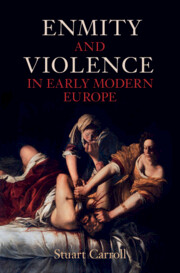Introduction
Published online by Cambridge University Press: 12 March 2023
Summary
The Introduction outlines the historigraphical, conceptual and methodological underpinnings of the work. The concept of enmity allows us to rethink some common assumptions about the emergence of the European state, the law, violence and innate emotions. I am concerned with real people and their experience. Enmity is rooted in the ubiquitous nature of competition and rivalry between individuals and groups. Enmity is distinguished by the intensification of antagonism in which another group or person is perceived as threatening and must be countered by force. It is a relationship legitimised by a narrative which seeks to demonise the other, who is characterised as evil or subversive or a threat to one’s existence. The movement is not all one-way. We can make allies out of enemies or return to a healthy sense of rivalry. Enmity represents a particular threat to democracy whose flourishing relies on a healthy civil society and sense of social trust. In the period 1500-1700 the distinction between public and private enemies was more blurred than it is today because of the frequency of civil conflict. The transformation of social relations in the West was not the culmination of an ineluctable process, either of state formation or of the repression of instinct.
- Type
- Chapter
- Information
- Enmity and Violence in Early Modern Europe , pp. 1 - 20Publisher: Cambridge University PressPrint publication year: 2023



